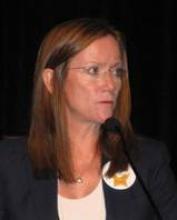DENVER – The majority of nuclear cardiology labs are not utilizing the American College of Cardiology appropriate use criteria for myocardial perfusion imaging, according to the preliminary results of an American Society of Nuclear Cardiology membership survey.
The revelation that only 48% of nuclear cardiology imaging labs employ the ACC appropriate use criteria is disturbing. It comes at a time when nuclear cardiologists are already drawing heat from payers, clinicians, patients, and Congress for perceived overutilization of testing and a casual attitude toward patient exposure to radiation.
The ACC’s appropriate use criteria (AUC) program is a high-profile quality improvement initiative. The myocardial perfusion imaging AUC were developed jointly by the ACC, ASNC, and other key specialty societies. Myocardial perfusion imaging (MPI) was the first topic selected for the program, which has since gone on to develop AUC for other common cardiovascular tests and procedures. MPI was selected to go first because of concerns raised by the explosive growth and substantial regional variation in the procedures. The initial version of the MPI AUC was published in 2005, with an updated rendition appearing 2 years ago (J. Am. Coll. Cardiol. 2009;53:2201-9).
ASNC President Leslee J. Shaw, Ph.D., presented the preliminary membership survey results during her presidential address at the annual meeting of the American Society of Nuclear Cardiology. She also took that occasion to unveil an ambitious new multifaceted ASNC campaign called "Excellence in Imaging." The program is designed to improve the practice of nuclear cardiology through education and advocacy, and by fostering high-quality research that demonstrates nuclear imaging’s clinical value. ASNC members who take the Excellence in Imaging pledge commit themselves to following the AUC.
"By taking a proactive stance on defining quality in nuclear cardiology and demonstrating our members’ commitment to these defined quality measures, ASNC will lead the discussion about appropriate use and set the standards by which our patients receive optimal care," promised Dr. Shaw, professor of medicine at Emory University, Atlanta.
"What the survey results say to me is that we need to do a better job of providing you with tools where you can see the value in improving your process of care, and how the AUC can be utilized to actually identify appropriate patient referral patterns and track your success. This is increasingly going to be a performance metric. Your rating for appropriate test candidates is going to be used as a quality metric," she explained.
The educational portion of the Excellence in Imaging campaign will not only include continuing medical education that is designed to raise the quality of imaging by ASNC members, but also webinars for referring physicians aimed at fostering appropriate referral patterns. Clinical decision support tools are being developed that can be embedded in smart phones to assist referring physicians in selecting the optimal test for a given patient, rather than leaving the testing decision to be made downstream when the patient arrives at the nuclear cardiology clinic. There will also be public education efforts to dispel widespread misconceptions about radiation safety.
Later, Dr. Manuel D. Cerqueira observed that shifting the timing of appropriate test decision making to the point when testing is ordered by referring physicians is "easy to say, hard to do."
No matter how many conversations he has with emergency department physicians at outlying hospitals about not sending him low-risk, inappropriate candidates for imaging procedures involving ionizing radiation exposure when there are better nonradioactive tests available, they continue to do so.
"They’re worried about liability, they’re worried about their 1-year contract that gets reviewed by the hospital, and they’re worried about the pressure the hospital puts on them to do more procedures that are lucrative for the hospital," said Dr. Cerqueira, professor of radiology and medicine and chairman of the nuclear medicine imaging institute at the Cleveland Clinic Foundation.
In a separate presentation, Dr. Robert C. Hendel, who chaired the writing group for the updated MPI AUC, said a dozen studies presented in the past 5 years demonstrate that 10%-15% of all MPIs are inappropriate, as defined by the AUC.
"Basically, if it’s an inappropriate indication, by definition the risks exceed the benefits. The best radiation safety we can do is not to perform the test – not to expose the patient – when it’s not necessary," explained Dr. Hendel, professor of medicine and radiology and director of cardiac imaging and outpatient services at the University of Miami.
He led a six-center study called SPECT-MPI involving roughly 6,000 consecutive patients who underwent single photon emission CT. Overall, inappropriate use of the procedure occurred in 14.4% of patients, with rates ranging from 4% to 22% among the practices.


